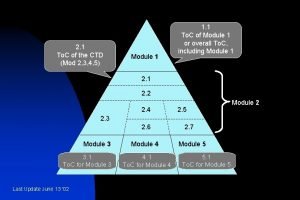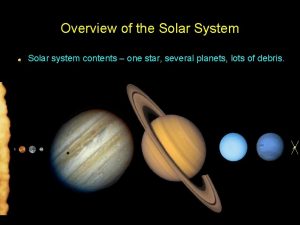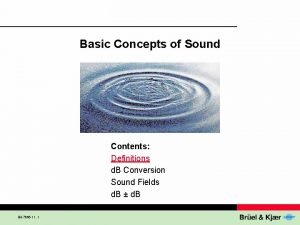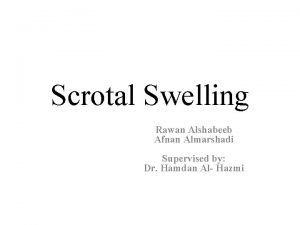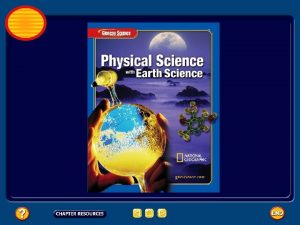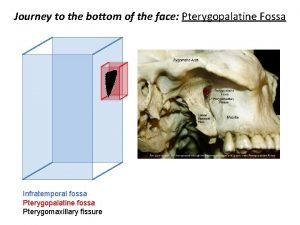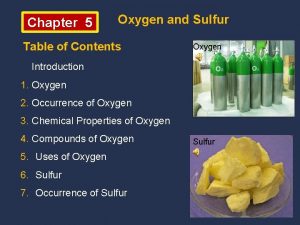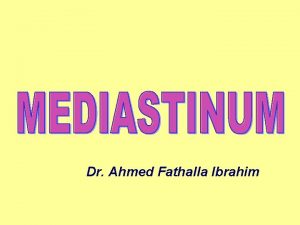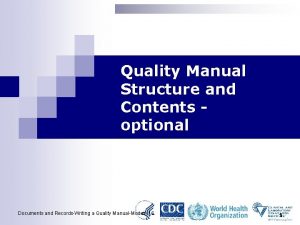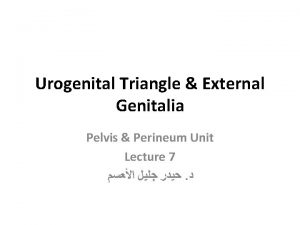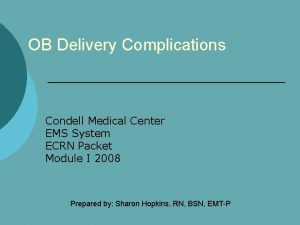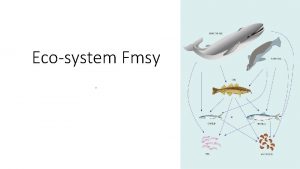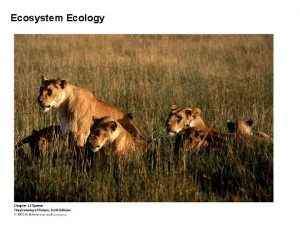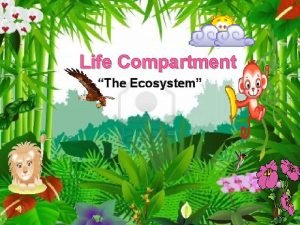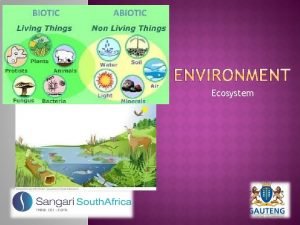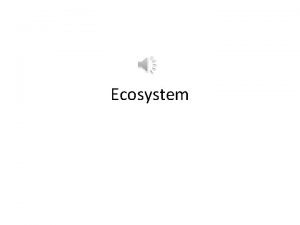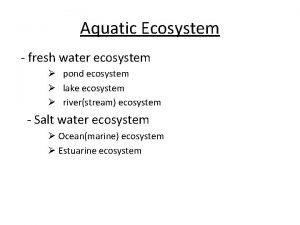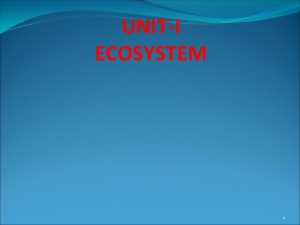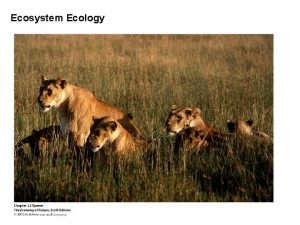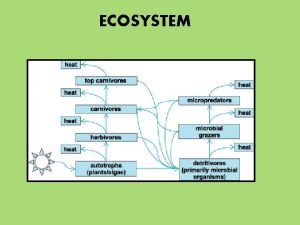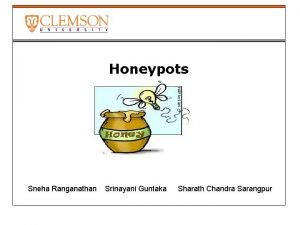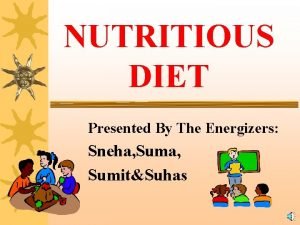Ecosystem Sneha mendhe Contents What is an ecosystem
























































- Slides: 56

Ecosystem Sneha mendhe

Contents What is an ecosystem Three major principles of ecosystem Components of an ecosystem Abiotic components Biotic components Movement of energy and nutrients Food chain Food webs Trophic levels, biomass and biome Linkages and interactions in an ecosystem Carbon cycle and oxygen cycle Model of nutrient cycle Environmental Limitation in ecosystem development.

What is an ecosystem An ecosystem is a grouping of organisms that interact with each other and their environment in such a way as to preserve the grouping. There is a great variety of ecosystems in existence, all of them are characterized by general structural and functional attributes.



Three major principles of ecosystem Nutrient cycling: Movement of chemical elements from the environment into living organisms and from them back into the environment through organisms live, grow, die and decompose. Energy flow: Energy is required to transform inorganic nutrients into organic tissues of an organism. Energy is the driving force to the work of ecosystem. Structure It refers to the particular pattern of interrelationships that exists between organisms in an ecosystem.

Nutrient cycling

Energy flow

Structure

Ecosystem: Nutrient cycling, energy flow and structure

Components of an ecosystem

Abiotic components They form the environment and determine the type / structure of ecosystem. Sunlight (temperature) Nutrients • Rainfall, minerals, carbon, nitrogen, …. . Type of ecosystems: Tropical rainforest, Desert, Tundra, Grassland, …. .

Distribution of vegetation / ecosystem

Biotic components Producers (Autotrophs): All green plants. They use solar energy, chlorophyll, inorganic nutrients and water to produce their own food. (Photosynthesis) Consumers: They consume the organic compounds in plant and animal tissues by eating. • Herbivores (plant feeders) Primary consumers • Carnivores (meat eaters) Secondary consumers • Omnivores (general feeders)

Biotic components Decomposers They are tiny organisms includes bacteria and fungi, which turn organic compounds in dead plants and animals into inorganic materials. They cause the continual recirculation of chemicals within ecosystem (nutrient cycle)


Biotic components and food chain

Movement of energy and nutrients Food chain Food webs Trophic level, biomass and biome

Food Chain The particular pathway of nutrient and energy movement depends on which organism feeds on anther. Decomposers

Food Webs

Trophic Levels A trophic level means a feeding level. First level – all producers Second level – all herbivores Third level – first level carnivores Fourth level – second level carnivores So on……. .

Trophic levels Energy and Nutrients passed through the ecosystem by food chains and webs from lower trophic level to the higher trophic level. However, only 5% to 20% energy and nutrients are transferred into higher trophic level successfully. For this reason, first trophic level has the largest number of organisms, and second trophic level is less than first one; the third level is less than second level, and so on.

Trophic levels


Biomass means the total combined weight of any specified group of organisms. The biomass of the first trophic level is the total weight of all the producers in a given area. Biomass decreases at higher trophic levels.

Biomass

Biomass and productivity


Trophic Level (Food Pyramid)

Biome This is a total different concept apart from Biomass. Biome are defined as “the world’s major communities, classified according to the predominant vegetation and characterized by adaptations of organism to that particular environment.

Linkages and Interactions in an ecosystem Carbon and Oxygen cycle Nitrogen cycle A model of nutrient cycle

Carbon Cycle and Oxygen Cycle



Nitrogen Cycle

Nitrogen cycle can be affected by man in five major ways: Fertilizer production (mainly nitrates and ammonium salts) to grow more food by increasing yields, and replenishing lost nitrogen from the soil. Burning of fossil fuels in cars, power plants, and heating which puts nitrogen dioxide into the atmosphere. Increasing animals wastes (nitrates) from more people and from livestock and poultry grown in ranches. Increased sewage flows from industry and urbanization. Increased erosion of and runoff nearby streams, lakes and rivers from cultivation, irrigation, agricultural wastes, mining, urbanization and poor land use.

Model of Nutrient Cycle Nutrients (chemicals, minerals or elements) are circulated around the ecosystem and recycled continually. Gersmehl identified three storage compartments. Litter: the surface layer of vegetation which may eventually become humus. Biomass: the total mass of living organisms, per unit area. Soil: the nutrients store in soil (weathered material) and semi-weathered material.

Model of Nutrient Cycle

3 Difference Nutrient Cycles

Environmental Limitation in ecosystem development Principles of limiting factors Law of the maximum Law of the minimum Principle of holocoenotic environment Limiting factors of an environment Light Temperature Water Wind Topography Soil Biotic factors

Law of Maximum and Minimum

Principle of holocoenotic environment A German ecologist Karl Friederich (1927) suggested that 'community-environmental relationship are holocoenotic'. This means that there are no 'walls' or barriers between the factors of an environment and the organism or biotic community. If one factor is changed, almost all will change eventually. Example: Temperature Air can hold more water Evaporation rates Dryness of soil Free water in soil Transpiration Relative Humidity Plants absorb soil water

Limiting factors of an environment Light Temperature Water Wind Topography Soil Biotic Factors

Light is an very important environment factor: Source of energy for ecosystem Control factor for reproduction and migration.

Light Quality of light: • Red and blue light: green plants (photosynthesis) • Green light: plants in woods or deep water • Ultraviolet light: retards plant growth Duration of light • Affect the behaviour of plants and animals (flowering, migration, mating…. ) Intensity of light: • Controlling factor for rate of photosynthesis • Net productivity is the function of photosynthesis and respiration.


Temperature Very important factor affecting Directly effects on organisms Indirectly effects in modifying other environmental factors such as relative humidity and water availability. Each species has its own minimum, maximum and optimum temperatures for life. (vary with age and water balances in the body) Aquatic life has narrower tolerance ranges for temperature than those which live on land. Tropical plants: > 15 o. C, Temperate cereals: >-2 o. C, Coniferous forests: withstand many degrees below

Water restrict ecosystem development because , most organisms need large amounts of water to survive. Water requirement for plants will vary both with environmental conditions and among different species. Actual rate of transpiration is the function of relative humidity Air movement Size of leaves Size of stomata

Water Plants classification by water requirement. Xerophytes: plants can survive in extremely arid areas. Halophytes: plants can survive in saline conditions Hydrophytes: plants live in water or in moist soil.

Wind can act as an environmental factor Directly by causing mechanical damage to plants Indirectly affecting relative humidity and evaporation rates. High wind speed increases the rate of transpiration. Mountain summits, coasts and open plains vegetation may be dwarfed as a result of wind action.

Topography can influence ecosystem development in three major ways. Direct effects of altitude on temperature • normal lapse rate (-6. 5 o. C/km) The combination of changes in temperature and relative humidity • an altitudinal zonation of ecosystems. Slope orientation and angle • South-facing slopes (in the northern hemisphere) are warmer and drier than north-facing slopes. • Angle of slope will be a critical factor in soil formation and drainage.

Topography

Topography

Soil Attributes of soils, such as texture, p. H, soil climate and organic content operate in a closely inter-related fashion to exert control on rates of decomposition nutrient cycling, plant distribution productivity.

Biotic Factors Biotic factors are the interactions that occur between living things. Some species are beneficial or even essential for the existence of others, whereas some may be harmful. The dominant plants will grow tallest and modify the light conditions for the rest of the community. Plants struggle for light will influence root development and the competition for water and nutrients in the soil. Many plants rely on animals for pollination and seed dispersal. Many animals are directly dependent on plants for food.

Biotic Factors Man is by far the most important biotic factor. Man modifies of ecosystems by fire, hunting and agriculture, …. . . Industrialization and the intensification of agriculture, man has obliterated large areas of natural systems and caused pollution of both terrestrial and aquatic habitats.
 Dr. sneha rajiv
Dr. sneha rajiv Neonatal resuscitation definition
Neonatal resuscitation definition Sneha fotedar
Sneha fotedar House of siby
House of siby Gmail
Gmail Dr sneha sood
Dr sneha sood Ctd module 5 table of contents
Ctd module 5 table of contents Solar system contents
Solar system contents Scrapbook table of contents
Scrapbook table of contents Annex table of contents
Annex table of contents Mla table of contents
Mla table of contents Science table of contents
Science table of contents External carotid artery terminal branches
External carotid artery terminal branches Crm vision examples
Crm vision examples Febrile non hemolytic transfusion reaction
Febrile non hemolytic transfusion reaction Clovis unified preschool
Clovis unified preschool Zetoc
Zetoc Dlginit
Dlginit Contents page epq
Contents page epq Sound contents
Sound contents Curriculum vitaem
Curriculum vitaem Ctd triangle
Ctd triangle What is vo
What is vo External conflict in contents of the dead man's pocket
External conflict in contents of the dead man's pocket Covering of the spermatic cord
Covering of the spermatic cord Matlab string builder
Matlab string builder Science project setup
Science project setup Contents training meridian
Contents training meridian Table of contents in report writing
Table of contents in report writing Suprasternal space of burns
Suprasternal space of burns The immortal life of henrietta lacks table of contents
The immortal life of henrietta lacks table of contents Spermatic cord contents mnemonic
Spermatic cord contents mnemonic Lacuna vasorum contents
Lacuna vasorum contents Ark of the covenant lampstand
Ark of the covenant lampstand Nature table of contents
Nature table of contents Glenohumeral ligament attachment
Glenohumeral ligament attachment Pterygopalatine fossa
Pterygopalatine fossa Work portfolio examples
Work portfolio examples City of ember summary
City of ember summary Contents of a marketing plan
Contents of a marketing plan Magazine contents page analysis
Magazine contents page analysis Contents background
Contents background Point out the wrong statement replication factor
Point out the wrong statement replication factor Oxygen table of contents
Oxygen table of contents Mediastinum
Mediastinum Contents of an abstract
Contents of an abstract Zone of fatty degeneration of tomes fibers
Zone of fatty degeneration of tomes fibers Engineer notepad
Engineer notepad Interactive notebook table of contents
Interactive notebook table of contents Ism familiarization
Ism familiarization Incisive foramen contents
Incisive foramen contents Quality manual contents
Quality manual contents Stylistic synonyms lexicology
Stylistic synonyms lexicology Urogenital triangle layers
Urogenital triangle layers Normal position of baby
Normal position of baby Triangles of neck
Triangles of neck Contents of audit memorandum
Contents of audit memorandum






